文章目录
一,了解 HDFS Java API
Hadoop文件系统API文档:https://hadoop.apache.org/docs/stable/hadoop-project-dist/hadoop-common/filesystem/index.html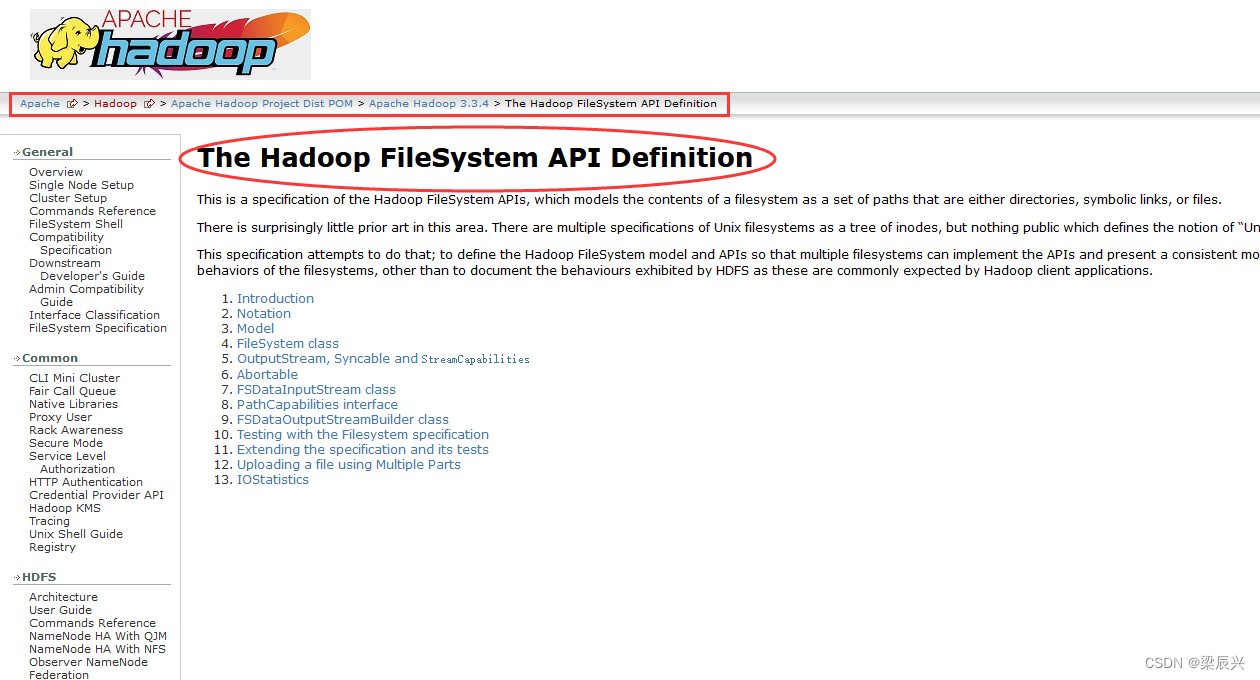
(一)HDFS常见类与接口
Hadoop整合了众多文件系统,HDFS只是这个文件系统的一个实例,下表整合了一些类或接口:
类或接口功能描述org.apache.hadoop.fs.FileSystem一个通用文件系统的抽象基类,可被分布式文件系统继承。org.apache.hadoop.fs.FileStatus文件状态接口,用于向客户端展示系统中文件和目录的元数据。具体包括文件大小、块大小、副本信息、所有者、修改时间等,可通过FileSystem.listStatus()方法获得具体的实例对象。org.apache.hadoop.fs.FileDataInputStream文件输入流,用于读取Hadoop文件。org.apache.hadoop.fs.FileDataOutputStream文件输出流,用于写Hadoop文件。org.apache.hadoop.fs.Configuration访问配置项,所有配置项的值,如果在core-site.xml中有对应的配置,则以core-site.xml为准。org.apache.hadoop.fs.Path路径,用于表示Hadoop文件系统中的一个文件或一个目录的路径。org.apache.hadoop.fs.PathFilter路径过滤器接口,通过实现方法PathFilter.accept(Path path)来判断
(二)FileSystem的常用方法
FileSystem类API文档:https://hadoop.apache.org/docs/stable/hadoop-project-dist/hadoop-common/filesystem/filesystem.html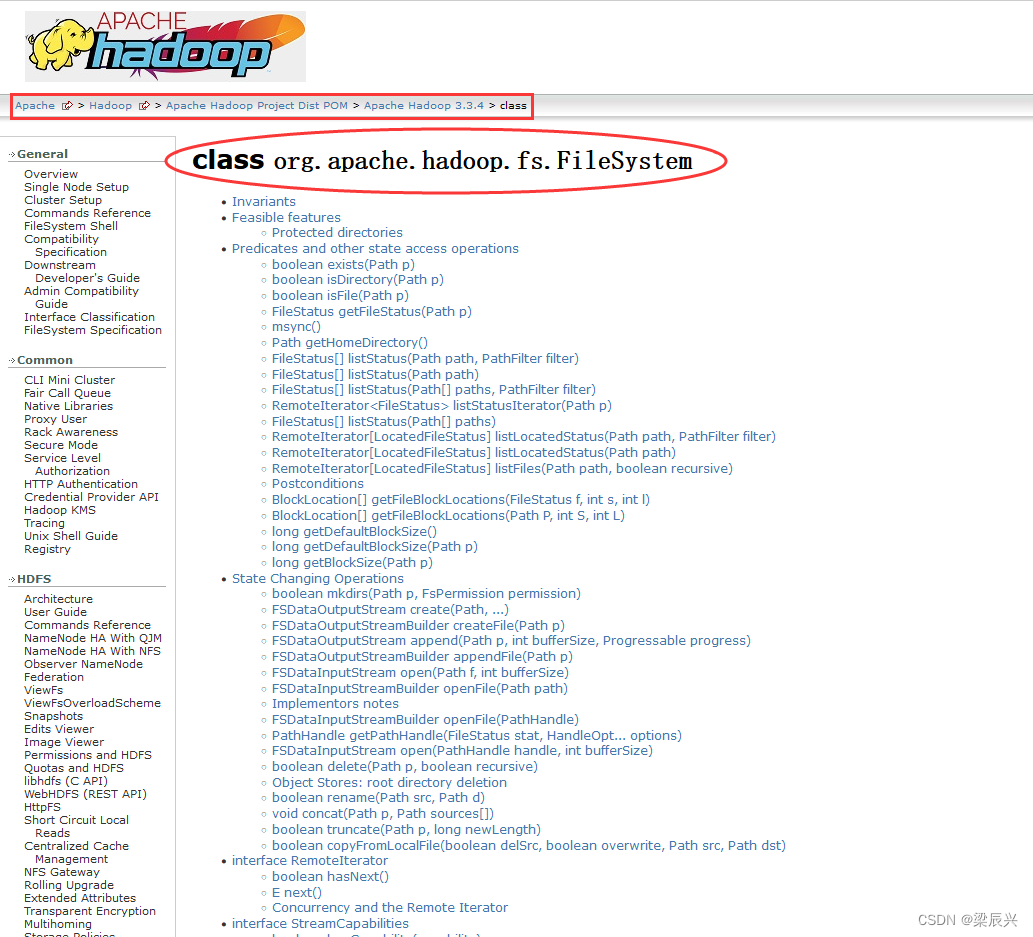
FileSystem对象的一些方法可以对文件进行操作,如下表所示:
方法名功能描述copyFromLocalFile(Path src, Path dst)从本地磁盘复制文件到HDFScopyToLocalFile(Path src, Path dst)从HDFS复制文件到本地磁盘mkdirs(Path f)建立子目录rename(Path src, Path dst)重命名文件或文件夹delete(Path f)删除指定文件
二,编写Java程序访问HDFS
01 创建Maven项目
创建名称为HDFSDemo的Maven项目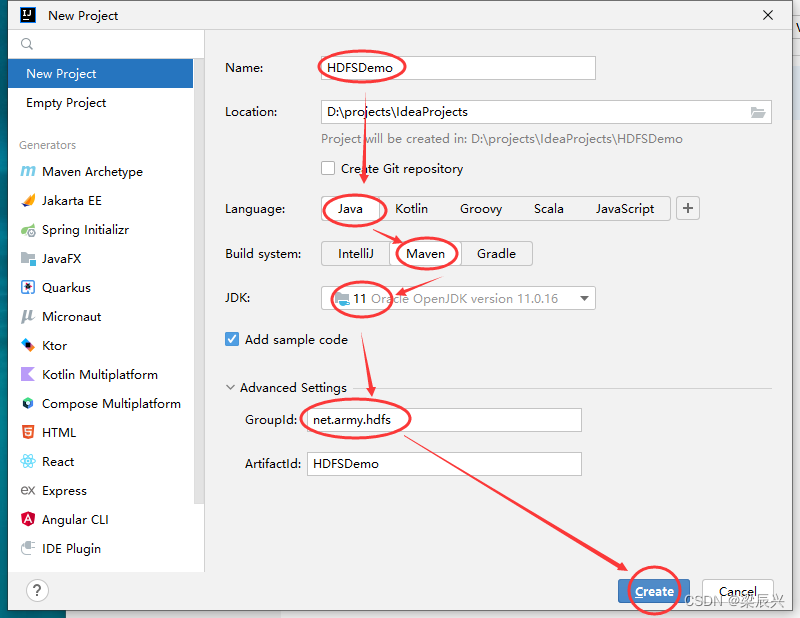
创建成功
02 添加相关依赖
在pom.xml文件里添加hadoop和junit依赖
1.在pox.xml文件中添加如下内容:
<dependencies><!--hadoop客户端--><dependency><groupId>org.apache.hadoop</groupId><artifactId>hadoop-client</artifactId><version>3.3.4</version></dependency><!--单元测试框架--><dependency><groupId>junit</groupId><artifactId>junit</artifactId><version>4.13.2</version></dependency></dependencies>
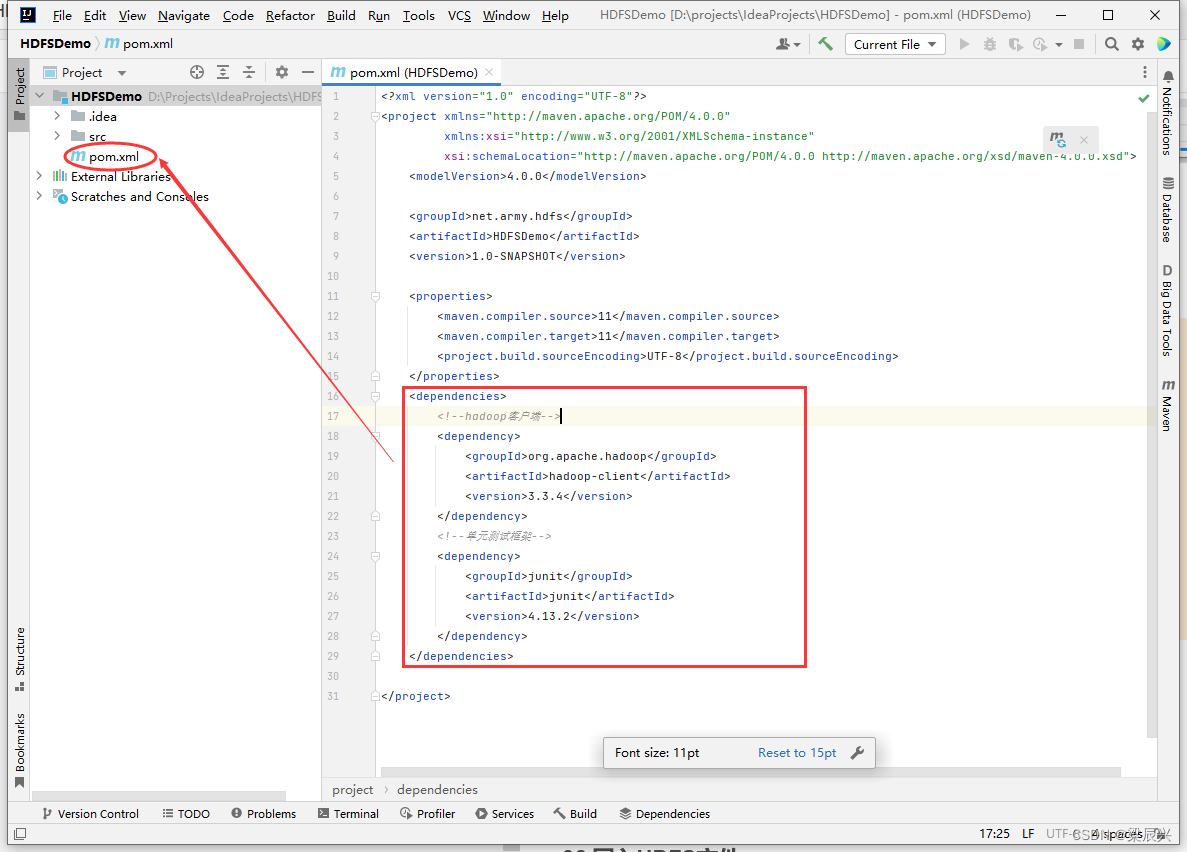
2.下载相关依赖到本地仓库 3.查看下载好的依赖
3.查看下载好的依赖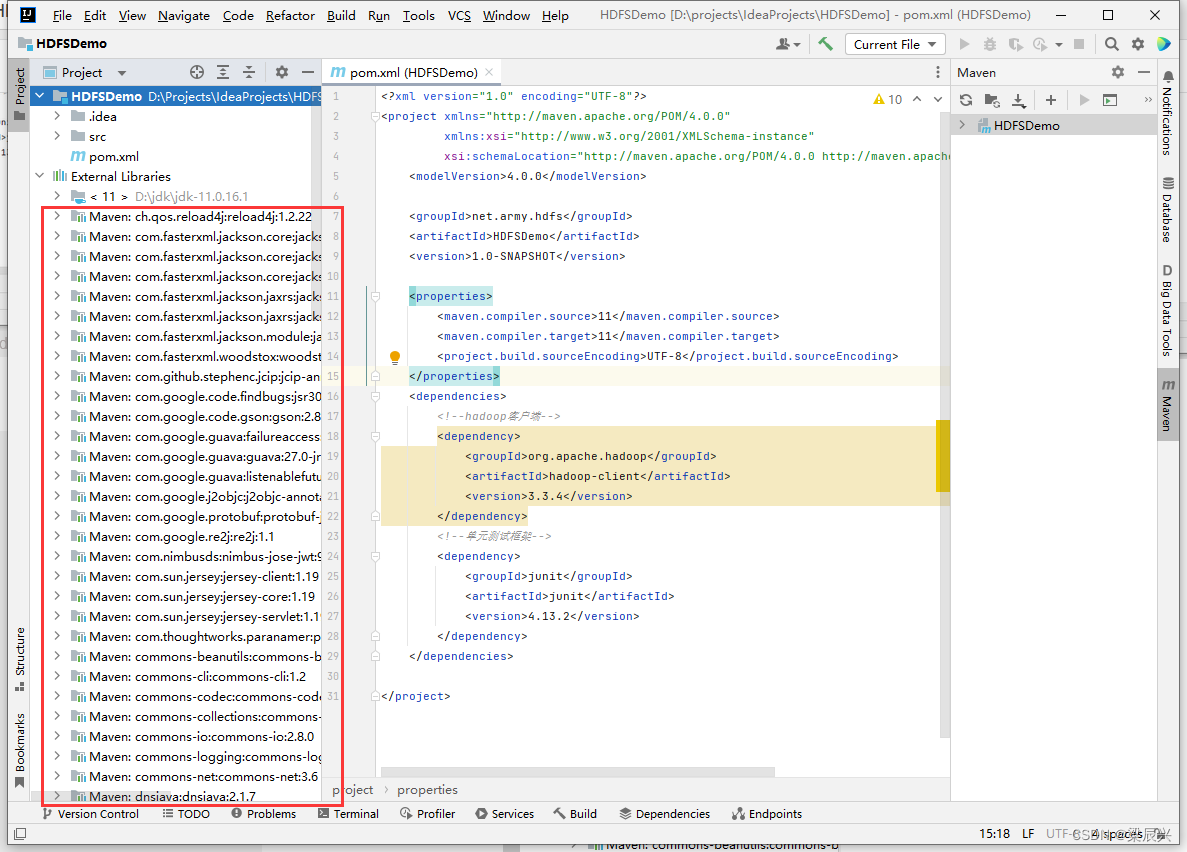
03 创建日志属性文件
(1)在resources目录里创建log4j.properties文件
1.右击【resources】,选择【New】,单击【Resource Bundle】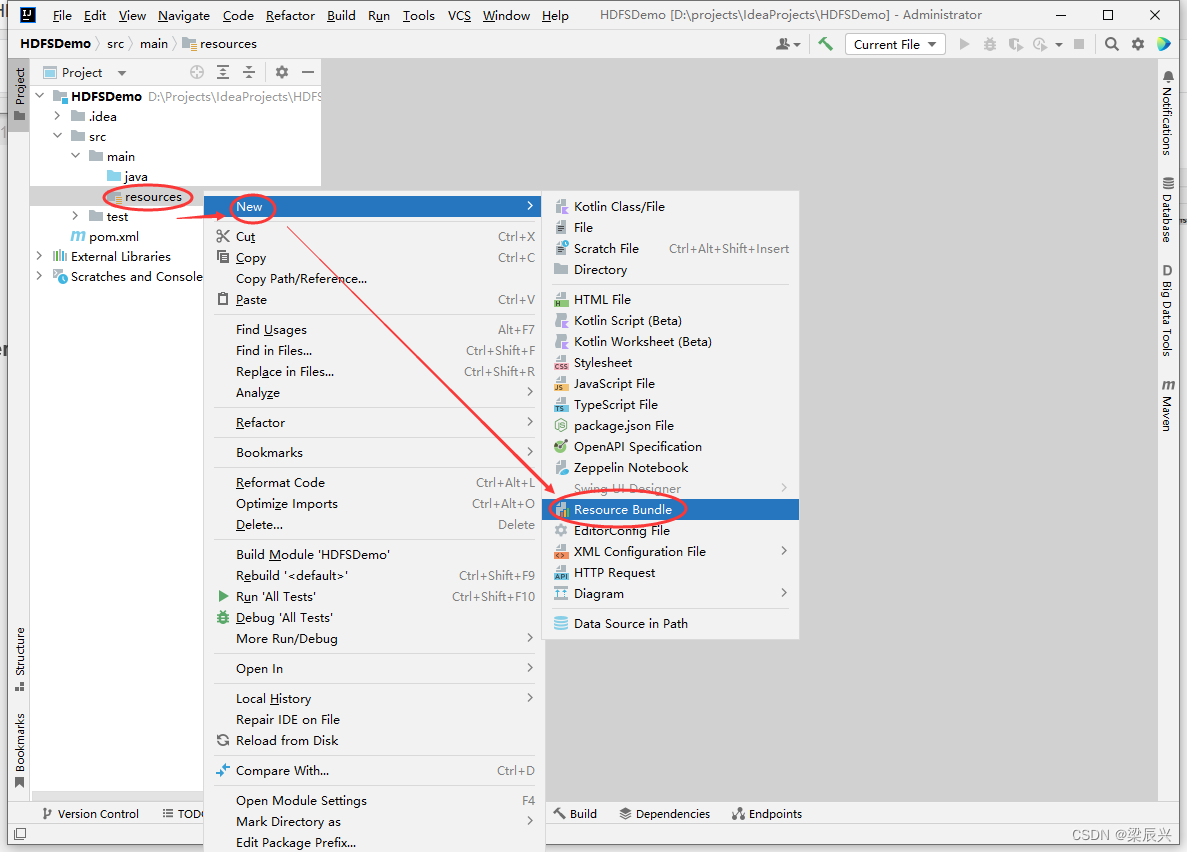 2.在弹出的对话框中输入log4j,按【ok】键,成功创建
2.在弹出的对话框中输入log4j,按【ok】键,成功创建
3.向log4j.properties文件中添加如下内容:
log4j.rootLogger=stdout, logfile
log4j.appender.stdout=org.apache.log4j.ConsoleAppender
log4j.appender.stdout.layout=org.apache.log4j.PatternLayout
log4j.appender.stdout.layout.ConversionPattern=%d %p [%c] - %m%n
log4j.appender.logfile=org.apache.log4j.FileAppender
log4j.appender.logfile.File=target/hdfs.log
log4j.appender.logfile.layout=org.apache.log4j.PatternLayout
log4j.appender.logfile.layout.ConversionPattern=%d %p [%c] - %m%n
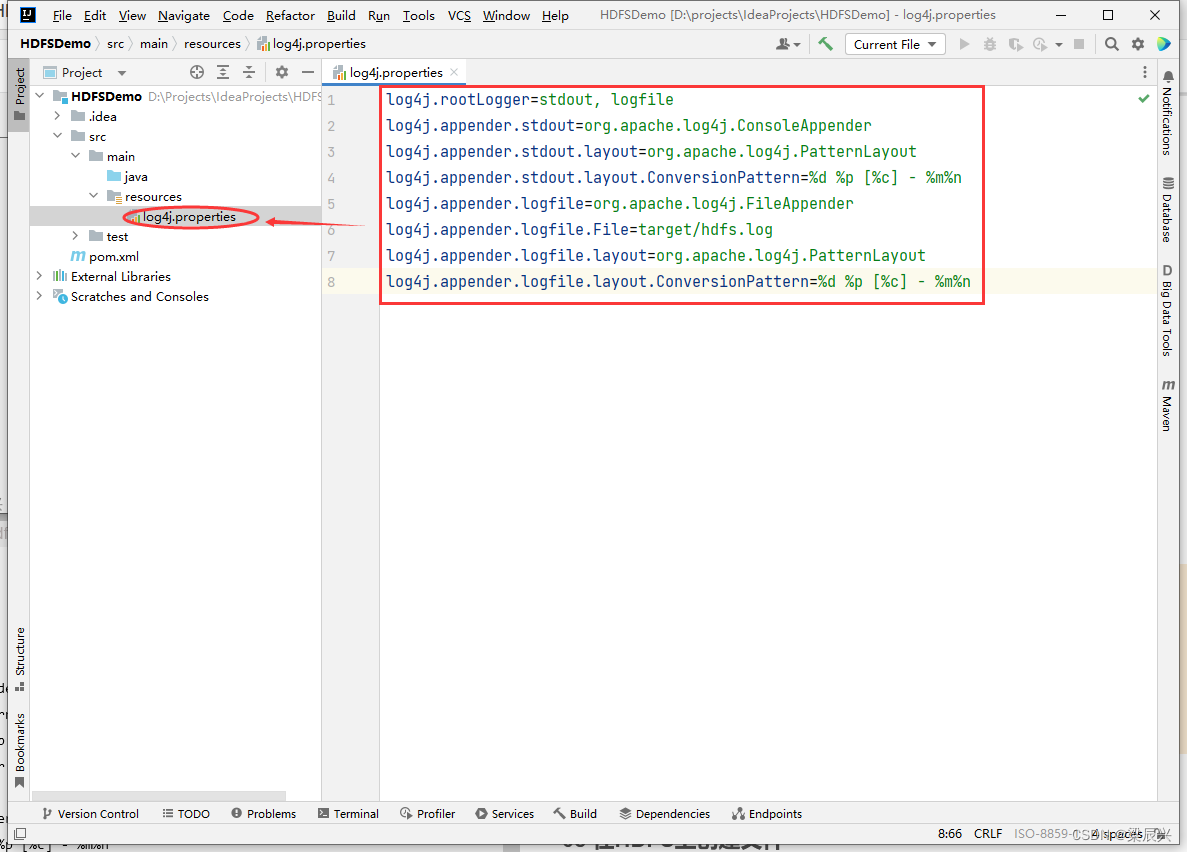
04 启动集群HDFS服务
在主节点输入命令:
start-dfs.sh
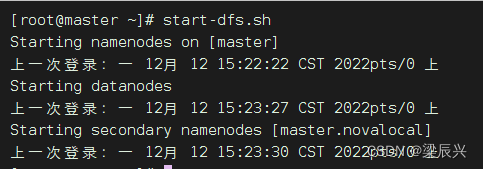
在Hadoop WebUI界面查看
05 在HDFS上创建文件
注:在HDFS Shell里利用hdfs dfs -touchz命令可以创建时间戳文件+
(1)创建net.army.hdfs包
1.右击【java】,选择【New】,单击【Package】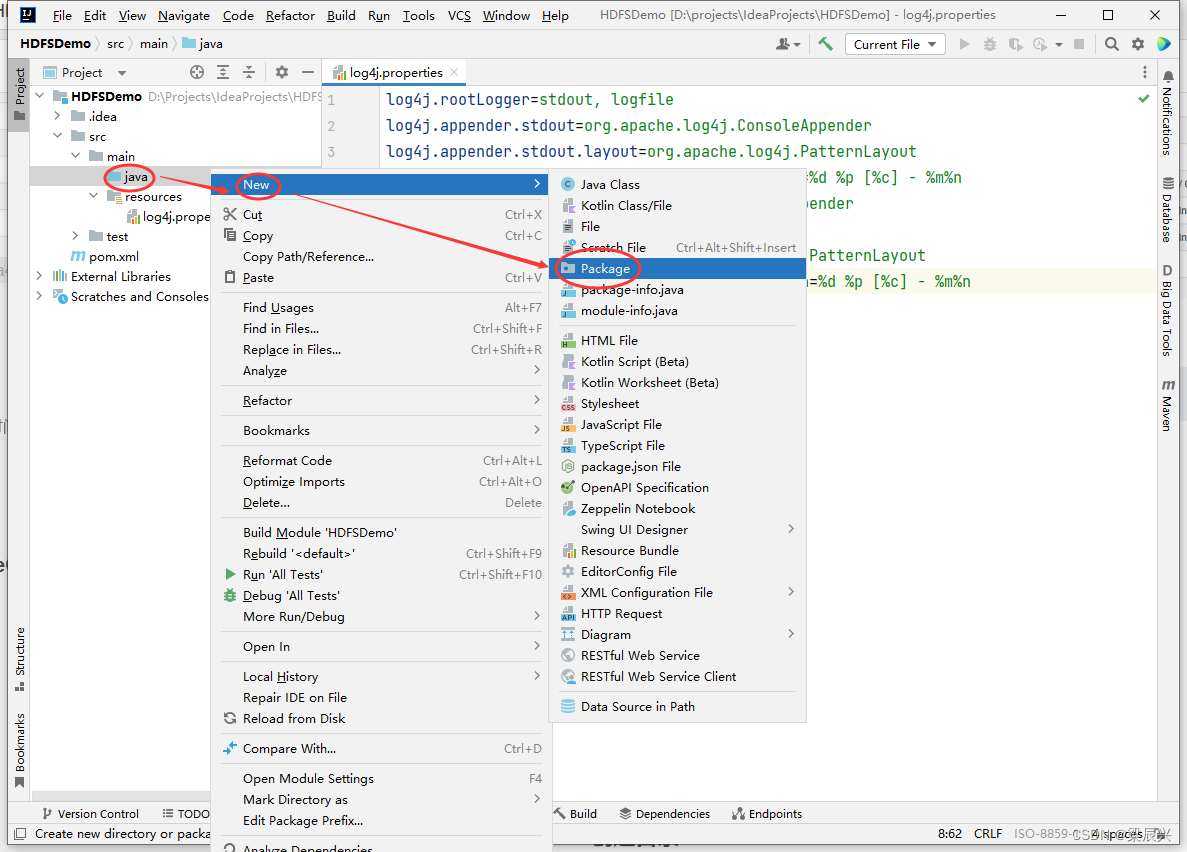 2.在弹出的对话框中输入:net.army.hdfs,按下回车键,创建成功
2.在弹出的对话框中输入:net.army.hdfs,按下回车键,创建成功
(2)在net.army.hdfs包里创建CreateFileOnHDFS类
1.右击【net.army.hdfs】包,选择【New】,单击【Java Class】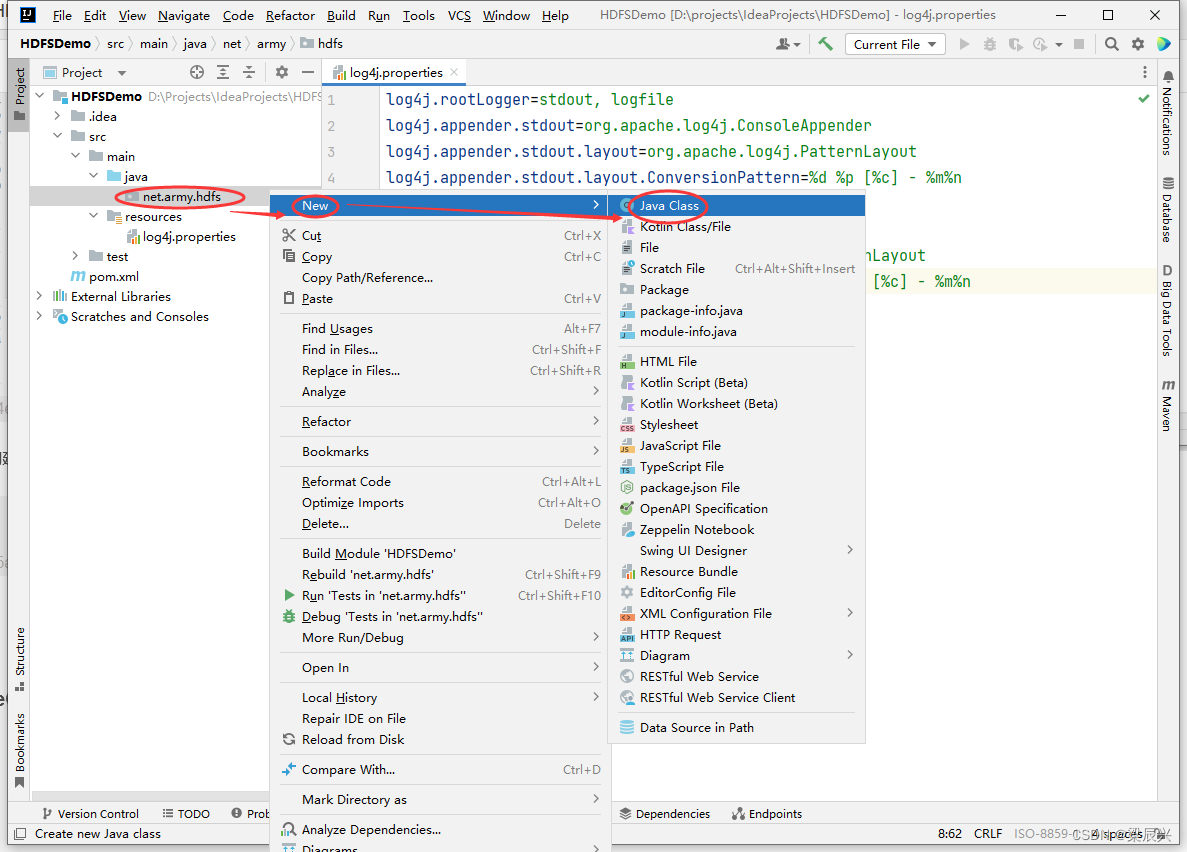 2.在弹出的对话框中输入:CreateFileOnHDFS,按下回车键,创建成功
2.在弹出的对话框中输入:CreateFileOnHDFS,按下回车键,创建成功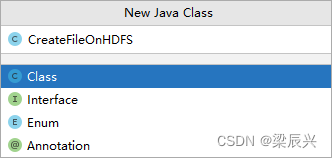
(3)编写create1()方法
create1()源码
@Testpublicvoidcreate1()throwsException{// 创建配置对象 Configuration conf =newConfiguration();// 定义统一资源标识符(uri: uniform resource identifier) String uri ="hdfs://master:9000";// 创建文件系统对象(基于HDFS的文件系统) FileSystem fs =FileSystem.get(newURI(uri), conf);// 创建路径对象(指向文件) Path path =newPath(uri +"/ied01/hadoop.txt");// 基于路径对象创建文件 boolean result = fs.createNewFile(path);// 根据返回值判断文件是否创建成功 if(result){System.out.println("文件["+ path +"]创建成功!");}else{System.out.println("文件["+ path +"]创建失败!");}}
注:导包不要导错了,请仔细对照
运行程序,查看结果 在Hadoop WebUI查看
在Hadoop WebUI查看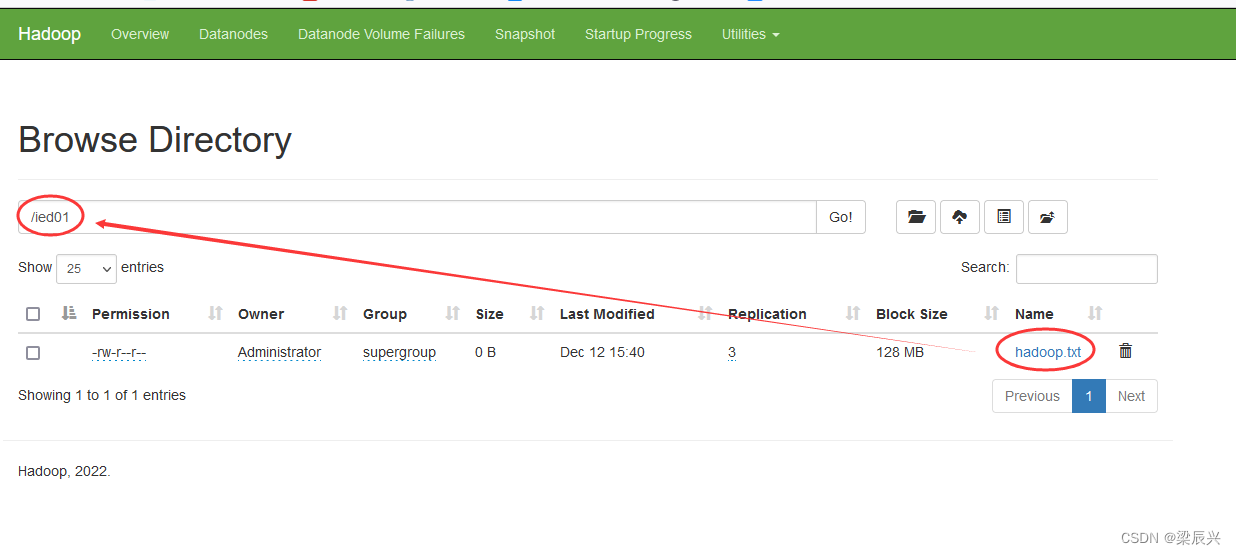
(4)编写create2()方法,事先判断文件是否存在
create2()源码
@Testpublicvoidcreate2()throwsException{// 创建配置对象 Configuration conf =newConfiguration();// 定义统一资源标识符(uri:uniform resource identifier) String uri ="hdfs://master:9000";// 创建文件系统对象(基于HDFS的文件系统) FileSystem fs =FileSystem.get(newURI(uri), conf);// 创建路径对象 Path path =newPath(uri +"/ied01/hadoop.txt");// 判断路径对象指向的文件是否存在 if(fs.exists(path)){// 提示用户文件已存在 System.out.println("文件["+ path +"]已经存在!");}else{// 基于路径对象创建文件 boolean result = fs.createNewFile(path);// 根据返回值判断文件是否创建成功 if(result){System.out.println("文件["+ path +"]创建成功!");}else{System.out.println("文件["+ path +"]创建失败!");}}}
运行程序,查看结果
06 写入HDFS文件
注:类似于HDFS Shell里的hdfs dfs -put命令
(1)在net.hw.hdfs包里创建WriteFileOnHDFS类
1.右击【net.army.hdfs】包,选择【New】,单击【Java Class】
2.在弹出的对话框中输入:WriteFileOnHDFS,按下回车键,创建成功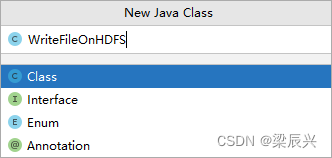
(2)将数据直接写入HDFS文件
创建write1()方法
write1()源码
@Testpublicvoidwrite1()throwsException{// 创建配置对象 Configuration conf =newConfiguration();// 定义统一资源标识符(uri: uniform resource identifier) String uri ="hdfs://master:9000";// 创建文件系统对象(基于HDFS的文件系统) FileSystem fs =FileSystem.get(newURI(uri), conf);// 创建路径对象(指向文件) Path path =newPath(uri +"/ied01/hello.txt");// 创建文件系统数据字节输出流(出水管:数据从程序到文件) FSDataOutputStream out = fs.create(path);// 通过字节输出流向文件写数据
out.write("Hello Hadoop World".getBytes());// 关闭文件系统数据字节输出流
out.close();// 关闭文件系统对象
fs.close();// 提示用户写文件成功 System.out.println("文件["+ path +"]写入成功!");}
运行write1()测试方法,查看结果,抛出RemoteException异常,三个数据节点都在运行,但是无法写入数据 修改代码,设置数据节点主机名属性,如下图所示
修改代码,设置数据节点主机名属性,如下图所示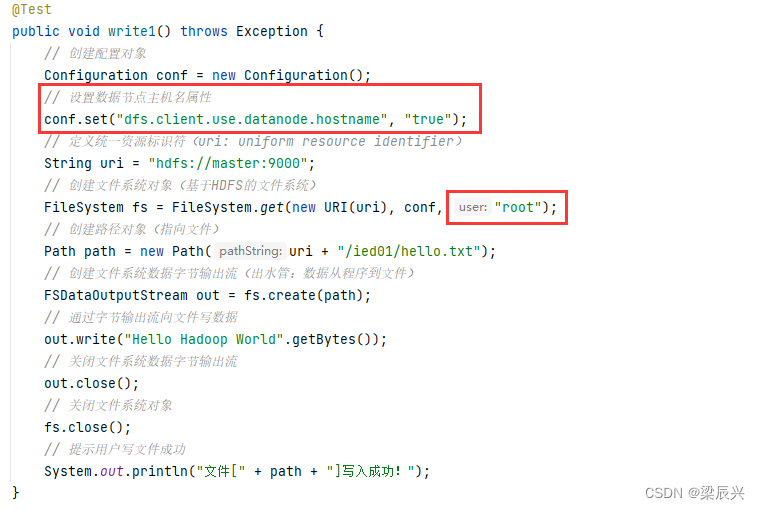 运行程序,查看结果
运行程序,查看结果 在Hadoop WebUI查看hello.txt文件
在Hadoop WebUI查看hello.txt文件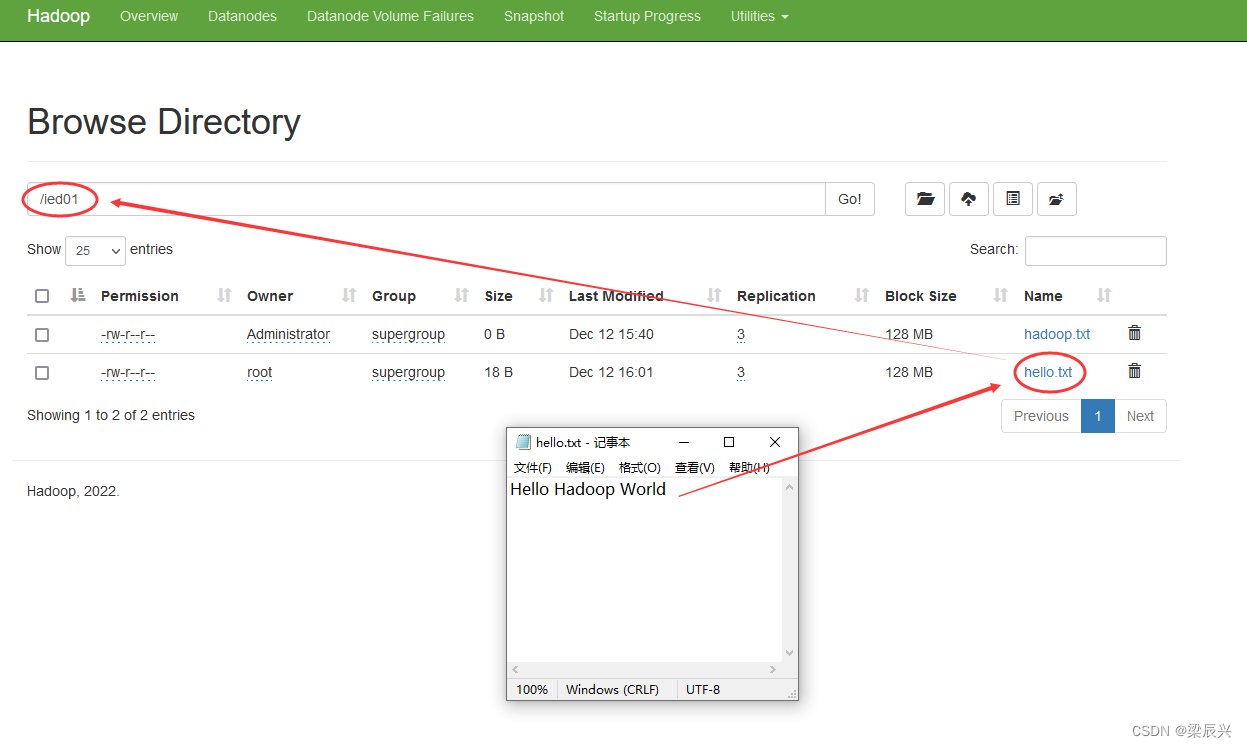
(3)将本地文件写入HDFS文件
在项目根目录创建一个文本文件test.txt
1.右击【HDFSDemo】,选择【New】,单击【File】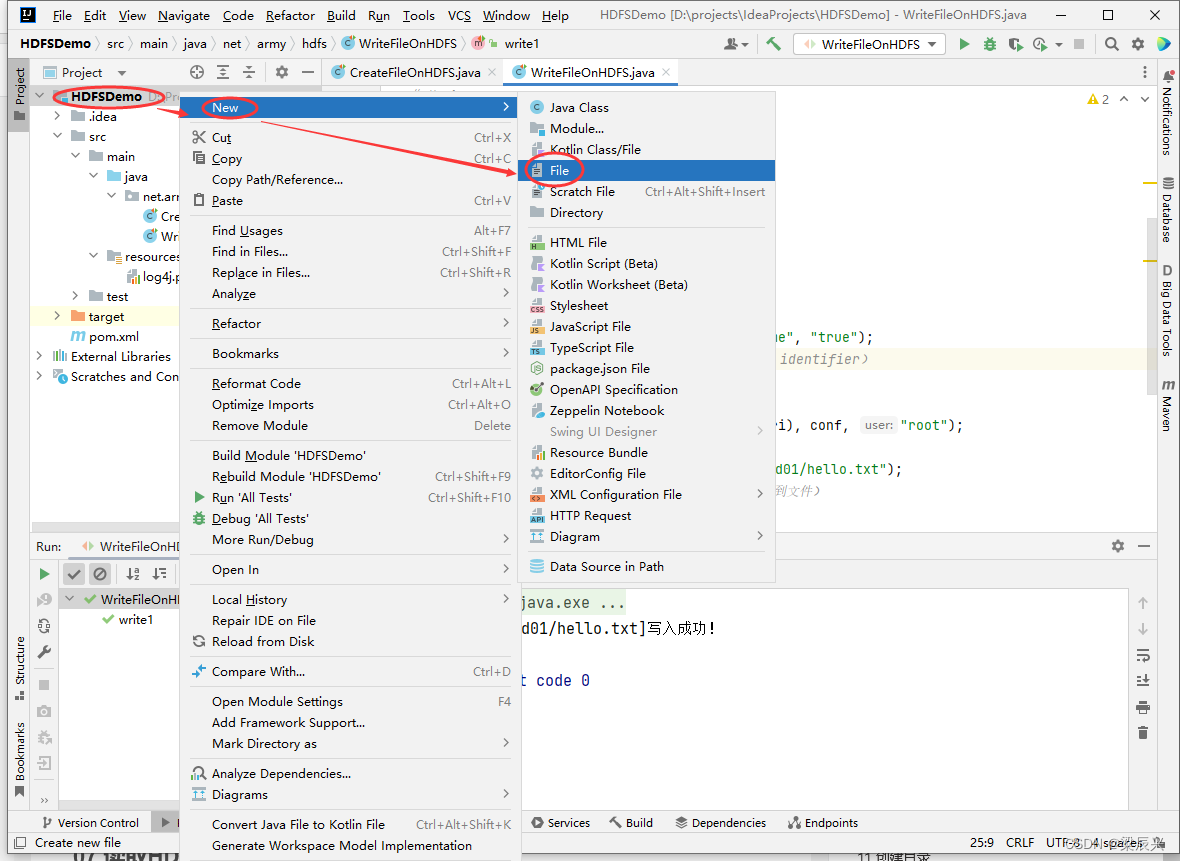 2.在弹出的对话框中输入test.txt,按下回车键,创建成功
2.在弹出的对话框中输入test.txt,按下回车键,创建成功
3.向test.txt文件添加如下内容:
hello linux world
hello hadoop world
hello zookeeper world
hello hive world
hell hbase world
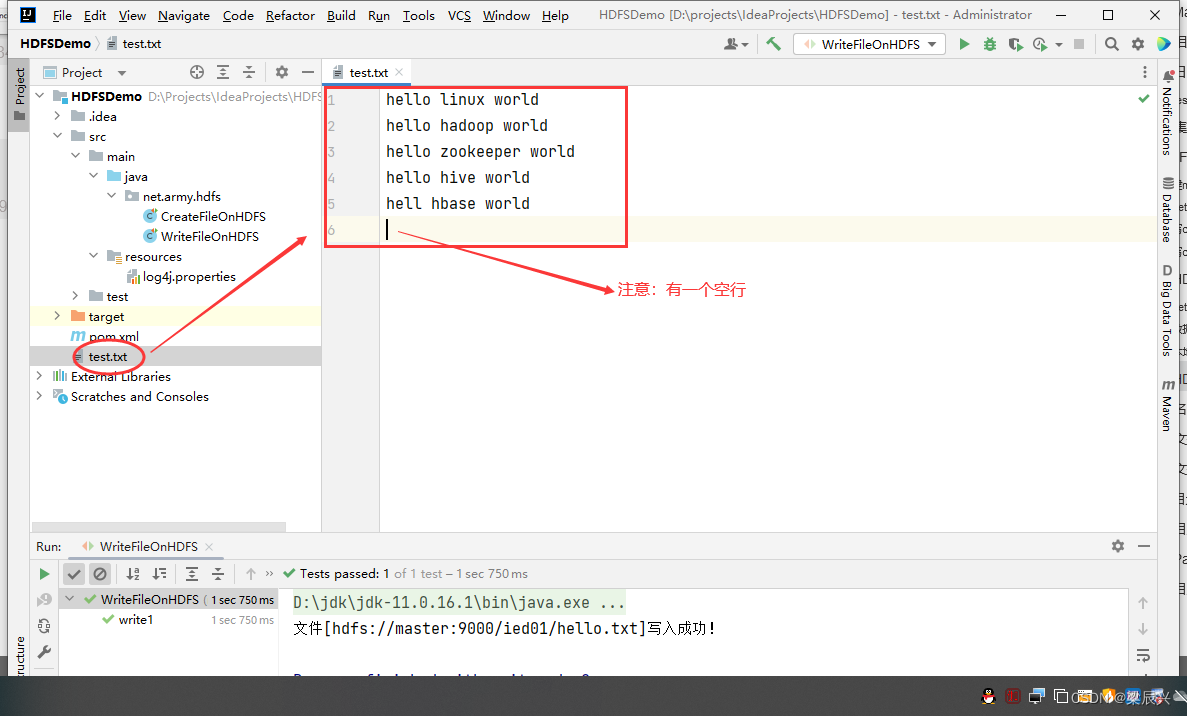
创建write2()方法
write2()源码
@Testpublicvoidwrite2()throwsException{// 创建配置对象 Configuration conf =newConfiguration();// 设置数据节点主机名属性
conf.set("dfs.client.use.datanode.hostname","true");// 定义统一资源标识符(uri: uniform resource identifier) String uri ="hdfs://master:9000";// 创建文件系统对象(基于HDFS的文件系统) FileSystem fs =FileSystem.get(newURI(uri), conf,"root");// 创建路径对象(指向文件) Path path =newPath(uri +"/ied01/exam.txt");// 创建文件系统数据字节输出流(出水管:数据从程序到文件) FSDataOutputStream out = fs.create(path);// 创建文件字符输入流对象(进水管:数据从文件到程序) FileReader fr =newFileReader("test.txt");// 创建缓冲字符输入流对象 BufferedReader br =newBufferedReader(fr);// 定义行字符串变量 String nextLine ="";// 通过循环遍历缓冲字符输入流 while((nextLine = br.readLine())!=null){// 在控制台输出读取的行 System.out.println(nextLine);// 通过文件系统数据字节输出流对象写入指定文件
out.write((nextLine +"\n").getBytes());}// 关闭缓冲字符输入流
br.close();// 关闭文件字符输入流
fr.close();// 关闭文件系统数据字节输出流
out.close();// 提示用户写入文件成功 System.out.println("本地文件[test.txt]成功写入["+ path +"]!");}
运行write2()测试方法,查看结果
查看/ied01/exam.txt内容,输入命令:
hdfs dfs -cat /ied01/exam.txt

注:其实这个方法的功能就是将本地文件复制(上传)到HDFS,有没有更简单的处理方法呢?有的,通过使用一个工具类IOUtils来完成文件的相关操作。
创建write3()方法
write3()源码
@Test
public void write3() throws Exception {
// 创建配置对象
Configuration conf = new Configuration();
// 设置数据节点主机名属性
conf.set("dfs.client.use.datanode.hostname", "true");
// 定义统一资源标识符(uri: uniform resource identifier)
String uri = "hdfs://master:9000";
// 创建文件系统对象(基于HDFS的文件系统)
FileSystem fs = FileSystem.get(new URI(uri), conf, "root");
// 创建路径对象(指向文件)
Path path = new Path(uri + "/ied01/test.txt");
// 创建文件系统数据字节输出流(出水管:数据从程序到文件)
FSDataOutputStream out = fs.create(path);
// 创建文件字节输入流(进水管:数据从文件到程序)
FileInputStream in = new FileInputStream("test.txt");
// 利用IOUtils类提供的字节拷贝方法在控制台显示文件内容
IOUtils.copyBytes(in, System.out, 1024, false);
// 利用IOUtils类提供的字节拷贝方法来复制文件
IOUtils.copyBytes(in, out, conf);
// 关闭文件字节输入流
in.close();
// 关闭文件系统数据字节输出流
out.close();
// 提示用户写入文件成功
System.out.println("本地文件[test.txt]成功写入[" + path + "]!");
}
运行write3()测试方法,查看结果
在webui界面查看创建的文件,大小为0B,说明没有成功写入,是怎么肥事呢? 原来是因为字节输入流的数据已经输出到到控制台,此时字节输入流里已经没有数据,此时执行IOUtils.copyBytes(in, out, conf);,因此输出流肯定也没有数据可以写入文件,那该怎么办呢?
原来是因为字节输入流的数据已经输出到到控制台,此时字节输入流里已经没有数据,此时执行IOUtils.copyBytes(in, out, conf);,因此输出流肯定也没有数据可以写入文件,那该怎么办呢?
那当然是再次读取文件,让字节输入流有数据。 运行write3()方法,查看结果
运行write3()方法,查看结果
再到webui界面,查看/ied01/test.txt文件,数据成功写入了
07 读取HDFS文件
注:相当于Shell里的两个命令:hdfs dfs -cat和hdfs dfs -get
(1)在net.hw.hdfs包里创建ReadFileOnHDFS类
1.右击【net.army.hdfs】包,选择【New】,单击【Java Class】
2.在弹出的对话框中输入:ReadFileOnHDFS,按下回车键,创建成功
(2)读取HDFS文件直接在控制台显示
准备读取hdfs://master:9000/ied01/test.txt文件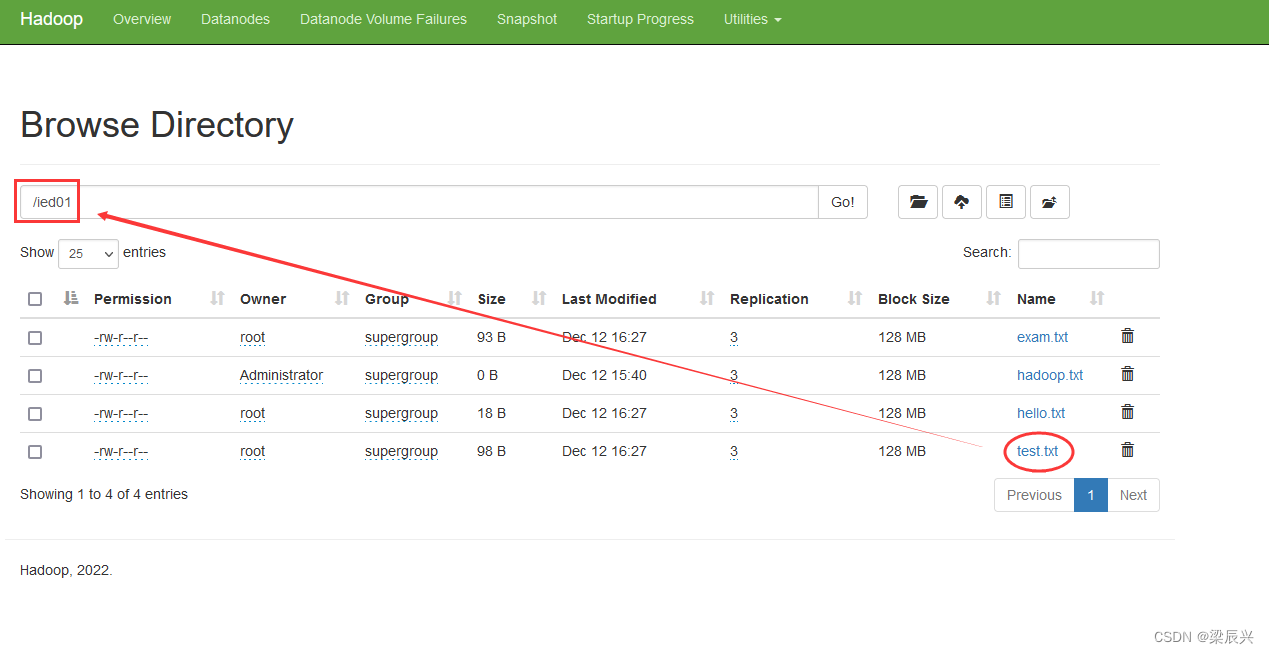 创建read1()方法
创建read1()方法
read1()源码
@Testpublicvoidread1()throwsException{// 创建配置对象 Configuration conf =newConfiguration();// 设置数据节点主机名属性
conf.set("dfs.client.use.datanode.hostname","true");// 定义统一资源标识符(uri: uniform resource identifier) String uri ="hdfs://master:9000";// 创建文件系统对象(基于HDFS的文件系统) FileSystem fs =FileSystem.get(newURI(uri), conf,"root");// 创建路径对象(指向文件) Path path =newPath(uri +"/ied01/test.txt");// 创建文件系统数据字节输入流(进水管:数据从文件到程序) FSDataInputStream in = fs.open(path);// 创建缓冲字符输入流,提高读取效率(字节流-->字符流-->缓冲流) BufferedReader br =newBufferedReader(newInputStreamReader(in));// 定义行字符串变量 String nextLine ="";// 通过循环遍历缓冲字符输入流 while((nextLine = br.readLine())!=null){// 在控制台输出读取的行 System.out.println(nextLine);}// 关闭缓冲字符输入流
br.close();// 关闭文件系统数据字节输入流
in.close();// 关闭文件系统
fs.close();}
运行read1()测试方法,查看结果 其实,我们可以使用IOUtils类来简化代码,创建read2()测试方法
其实,我们可以使用IOUtils类来简化代码,创建read2()测试方法
read2()源码
@Testpublicvoidread2()throwsException{// 创建配置对象 Configuration conf =newConfiguration();// 设置数据节点主机名属性
conf.set("dfs.client.use.datanode.hostname","true");// 定义统一资源标识符(uri: uniform resource identifier) String uri ="hdfs://master:9000";// 创建文件系统对象(基于HDFS的文件系统) FileSystem fs =FileSystem.get(newURI(uri), conf,"root");// 创建路径对象(指向文件) Path path =newPath(uri +"/ied01/test.txt");// 创建文件系统数据字节输入流(进水管:数据从文件到程序) FSDataInputStream in = fs.open(path);// 读取文件在控制台显示,显示完后关闭流 IOUtils.copyBytes(in,System.out,1024,true);}
运行read2()测试方法,查看结果
(3)读取HDFS文件,保存为本地文件
任务:将/ied01/test.txt下载到项目的download目录里
创建download目录
右击【HDFSDemo】,选择【New】,单击【Directory】,在弹出的对话框中输入:download,按下回车键,创建成功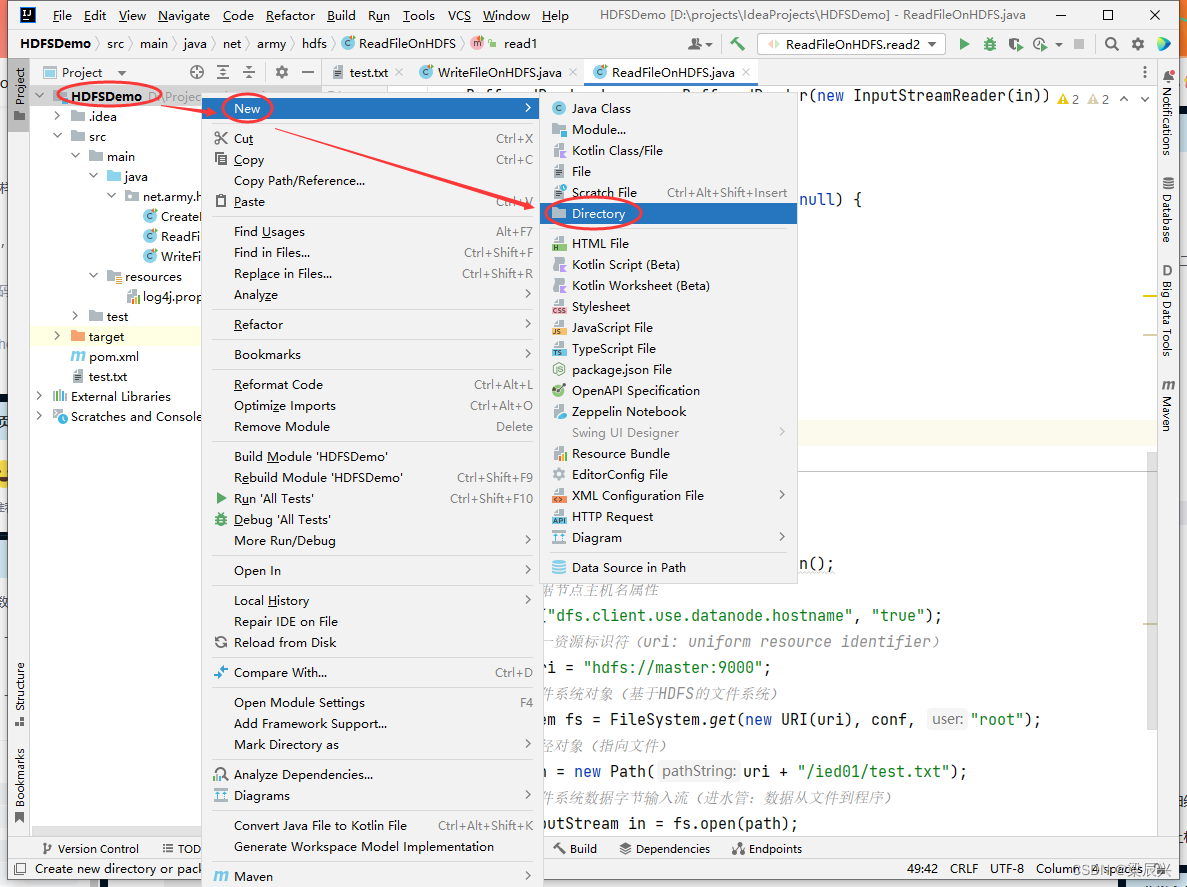

 创建read3()方法
创建read3()方法
read()3源码
@Testpublicvoidread3()throwsException{// 创建配置对象 Configuration conf =newConfiguration();// 设置数据节点主机名属性
conf.set("dfs.client.use.datanode.hostname","true");// 定义统一资源标识符(uri: uniform resource identifier) String uri ="hdfs://master:9000";// 创建文件系统对象(基于HDFS的文件系统) FileSystem fs =FileSystem.get(newURI(uri), conf,"root");// 创建路径对象(指向文件) Path path =newPath(uri +"/ied01/test.txt");// 创建文件系统数据字节输入流(进水管:数据从文件到程序) FSDataInputStream in = fs.open(path);// 创建文件字节输出流(出水管:数据从程序到文件) FileOutputStream out =newFileOutputStream("download/exam.txt");// 利用IOUtils工具类读取HDFS文件(靠输入流),写入本地文件(靠输出流) IOUtils.copyBytes(in, out, conf);// 关闭文件字节输出流
out.close();// 关闭文件系统数据字节流输入流
in.close();// 关闭文件系统
fs.close();// 提示用户文件下载成功 System.out.println("文件["+ path +"]下载到本地文件[download/exam.txt]!");}
运行read3()测试方法,查看结果
08 重命名目录或文件
注:相当于Shell里的hdfs dfs -mv命令
(1)在net.hw.hdfs包里创建RenameDirOrFile类
1.右击【net.army.hdfs】包,选择【New】,单击【Java Class】 2.在弹出的对话框中输入:RenameDirOrFile,按下回车键,创建成功
2.在弹出的对话框中输入:RenameDirOrFile,按下回车键,创建成功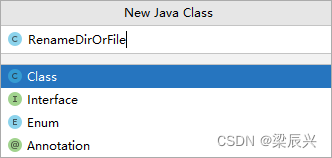
(2)重命名目录
任务:将/ied01目录更名为/lzy01
编写renameDir()方法
renameDir()源码
@TestpublicvoidrenameDir()throwsException{// 创建配置对象 Configuration conf =newConfiguration();// 设置数据节点主机名属性
conf.set("dfs.client.use.datanode.hostname","true");// 定义统一资源标识符(uri: uniform resource identifier) String uri ="hdfs://master:9000";// 创建文件系统对象(基于HDFS的文件系统) FileSystem fs =FileSystem.get(newURI(uri), conf,"root");// 创建源路径对象(指向目录) Path sourcePath =newPath(uri +"/ied01");// 创建目标路径对象(指向目录) Path destinationPath =newPath(uri +"/lzy01");// 利用文件系统对象重命名目录
fs.rename(sourcePath, destinationPath);// 关闭文件系统
fs.close();// 提示用户目录更名成功 System.out.println("目录["+ sourcePath.getName()+"]更名为目录["+ destinationPath.getName()+"]!");}
运行renameDir()方法,查看结果 在Hadoop WebUI界面查看
在Hadoop WebUI界面查看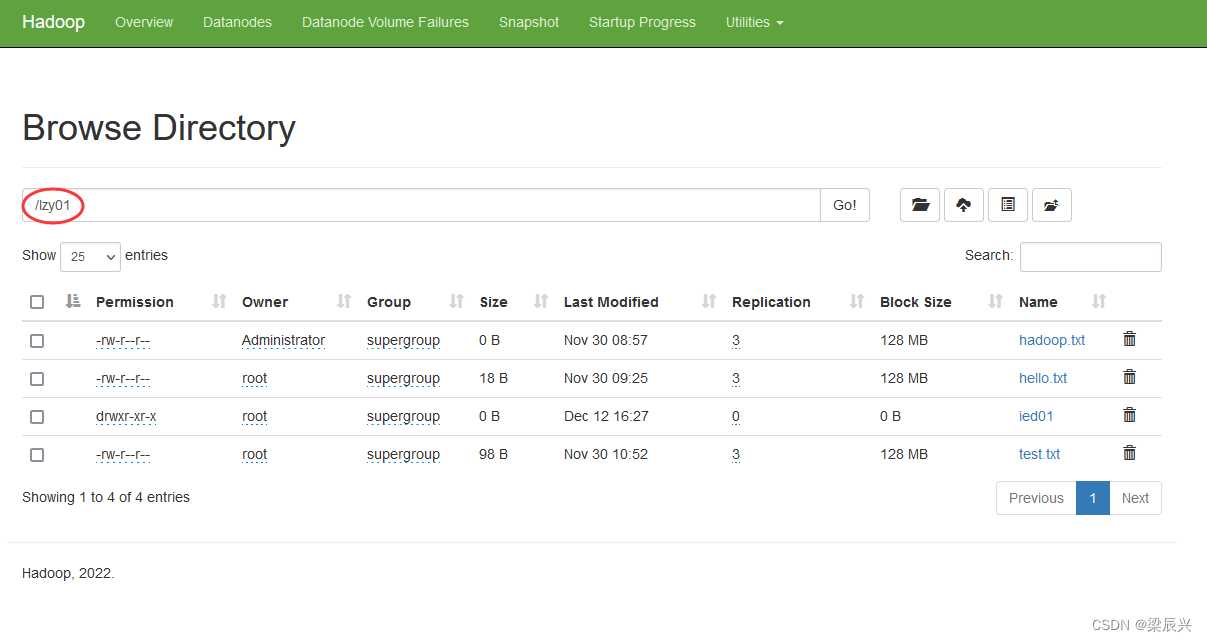
(3)重命名文件
任务:将lzy01目录下的hello.txt重命名为hi.txt
创建renameFile()方法
renameFile()源码
@TestpublicvoidrenameFile()throwsException{// 创建配置对象 Configuration conf =newConfiguration();// 设置数据节点主机名属性
conf.set("dfs.client.use.datanode.hostname","true");// 定义统一资源标识符(uri: uniform resource identifier) String uri ="hdfs://master:9000";// 创建文件系统对象(基于HDFS的文件系统) FileSystem fs =FileSystem.get(newURI(uri), conf,"root");// 创建源路径对象(指向文件) Path sourcePath =newPath(uri +"/lzy01/hello.txt");// 创建目标路径对象(指向文件) Path destinationPath =newPath(uri +"/lzy01/hi.txt");// 利用文件系统对象重命名文件
fs.rename(sourcePath, destinationPath);// 关闭文件系统
fs.close();// 提示用户文件更名成功 System.out.println("文件["+ sourcePath.getName()+"]更名为文件["+ destinationPath.getName()+"]!");}
运行renameFile()测试方法,查看结果 在Hadoop WebUI界面查看
在Hadoop WebUI界面查看
09 显示文件列表
(1)在net.hw.hdfs包里创建ListHDFSFiles类
1.右击【net.army.hdfs】包,选择【New】,单击【Java Class】
2.在弹出的对话框中输入:ListHDFSFiles,按下回车键,创建成功
(2)显示指定目录下文件全部信息
任务:显示/lzy01目录下的文件列表
 创建list1()方法
创建list1()方法 文件系统对象的listFiles()方法第二个参数设置true,这样可以将/lzy01目录的一切文件,包括子目录里的文件,都一网打尽
文件系统对象的listFiles()方法第二个参数设置true,这样可以将/lzy01目录的一切文件,包括子目录里的文件,都一网打尽
list1()源码
@Testpublicvoidlist1()throwsException{// 创建配置对象 Configuration conf =newConfiguration();// 设置数据节点主机名属性
conf.set("dfs.client.use.datanode.hostname","true");// 定义uri字符串 String uri ="hdfs://master:9000";// 创建文件系统对象 FileSystem fs =FileSystem.get(newURI(uri), conf,"root");// 创建远程迭代器对象,泛型是位置文件状态类(相当于`hdfs dfs -ls -R /lzy01`) RemoteIterator<LocatedFileStatus> ri = fs.listFiles(newPath("/lzy01"),true);// 遍历远程迭代器 while(ri.hasNext()){System.out.println(ri.next());}}
运行list1()测试方法,查看结果
上述文件状态对象封装的有关信息,可以通过相应的方法来获取,比如getPath()方法就可以获取路径信息,getLen()方法就可以获取文件长度信息……
(3)显示指定目录下文件路径和长度信息
编写list2()方法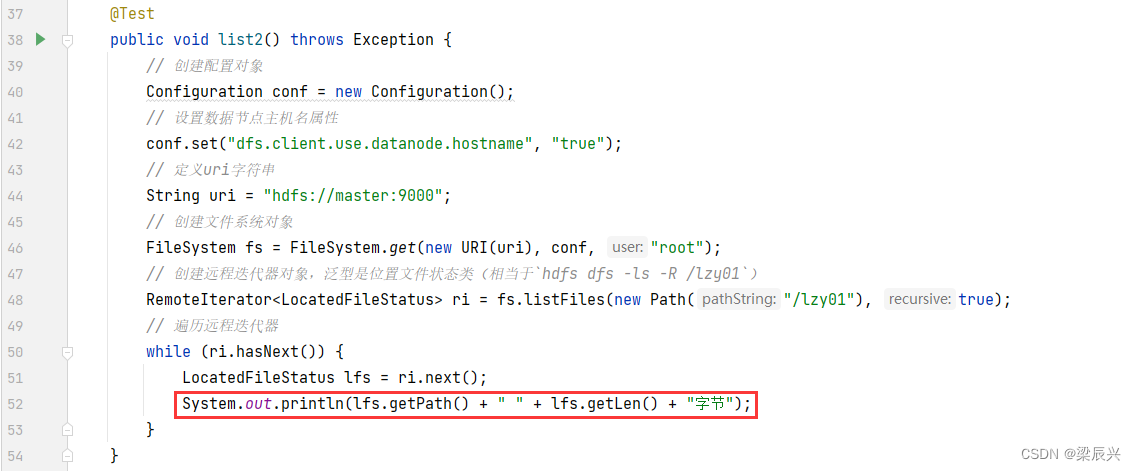
list2()源码
@Testpublicvoidlist2()throwsException{// 创建配置对象 Configuration conf =newConfiguration();// 设置数据节点主机名属性
conf.set("dfs.client.use.datanode.hostname","true");// 定义uri字符串 String uri ="hdfs://master:9000";// 创建文件系统对象 FileSystem fs =FileSystem.get(newURI(uri), conf,"root");// 创建远程迭代器对象,泛型是位置文件状态类(相当于`hdfs dfs -ls -R /lzy01`) RemoteIterator<LocatedFileStatus> ri = fs.listFiles(newPath("/lzy01"),true);// 遍历远程迭代器 while(ri.hasNext()){LocatedFileStatus lfs = ri.next();System.out.println(lfs.getPath()+" "+ lfs.getLen()+"字节");}}
运行list2()测试方法,查看结果 对照Hadoop WebUI上给出的文件长度信息
对照Hadoop WebUI上给出的文件长度信息
10 获取文件块信息
任务:获取/lzy01/apache-hive-3.1.3-bin.tar.gz文件块信息
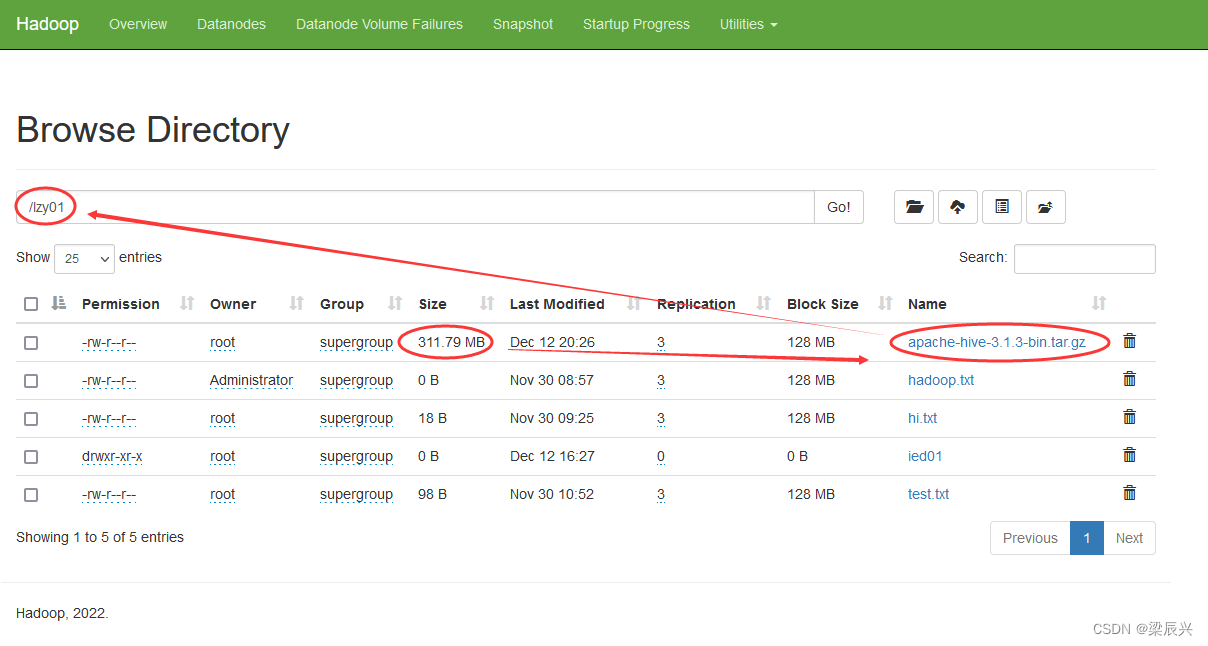
hive压缩包会分割成3个文件块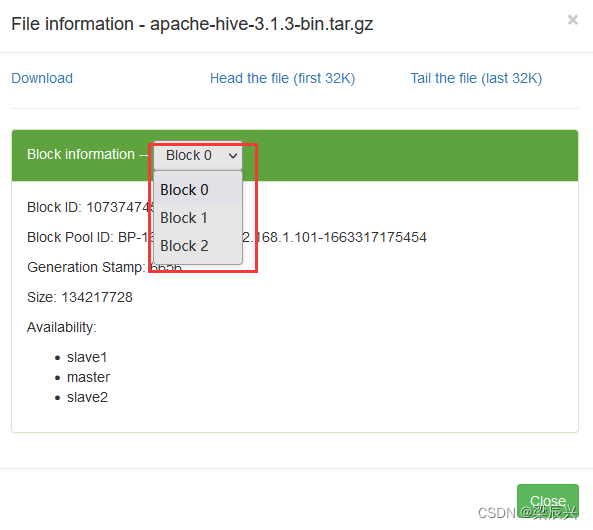
(1)在net.hw.hdfs包里创建GetBlockLocations类
1.右击【net.army.hdfs】包,选择【New】,单击【Java Class】
2.在弹出的对话框中输入:GetBlockLocations,按下回车键,创建成功
(2)用getFileBlockLocations()方法来获取物理切块信息

注:参数说明
- Path p:文件路径
- long start:起点
- long len:长度
(3)编写代码,获取文件块信息

源码:
packagenet.army.hdfs;importorg.apache.hadoop.conf.Configuration;importorg.apache.hadoop.fs.BlockLocation;importorg.apache.hadoop.fs.FileSystem;importorg.apache.hadoop.fs.Path;importjava.net.URI;importjava.util.Arrays;/**
* 作者:Army
* 日期:2022/12/12
* 功能:获取文件块信息
*/publicclassGetBlockLocations{publicstaticvoidmain(String[] args)throwsException{// 创建配置对象Configuration conf =newConfiguration();// 设置数据节点主机名属性
conf.set("dfs.client.use.datanode.hostname","true");// 定义uri字符串String uri ="hdfs://master:9000";// 创建文件系统对象FileSystem fs =FileSystem.get(newURI(uri), conf,"root");// 创建路径对象,指向文件Path path =newPath("/lzy01/apache-hive-3.1.3-bin.tar.gz");// 获取文件块信息BlockLocation[] blks = fs.getFileBlockLocations(path,0,Integer.MAX_VALUE);// 利用Lambda表达式遍历块信息Arrays.asList(blks).forEach(blk ->System.out.println(blk));}}
尝试用传统for循环、增强for循环或迭代器来遍历块信息
// 利用增强for循环遍历块信息 for(BlockLocation blk : blks){System.out.println(blk);}// 利用传统for循环遍历块信息 for(int i =0; i < blks.length; i++){System.out.println(blks[i]);}// 利用迭代器遍历块信息 Iterator<BlockLocation> iterator =Arrays.asList(blks).iterator();while(iterator.hasNext()){System.out.println(iterator.next());}
运行程序,查看结果(切点位置,块大小,块存在位置)
由此可见,apache-hive-3.1.3-bin.tar.gz被hive物理切分成3块,前2块长度均为134217728字节(128MB),第3块长度为58505211字节(55.80MB)。
11 创建目录
任务:在HDFS上创建/ied01目录
(1)在net.hw.hdfs包里创建MakeDirOnHDFS类
1.右击【net.army.hdfs】包,选择【New】,单击【Java Class】
2.在弹出的对话框中输入:MakeDirOnHDFS,按下回车键,创建成功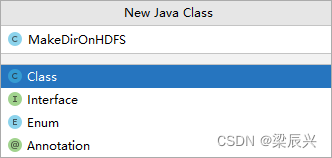
(2)编写代码,创建目录
源代码
packagenet.army.hdfs;importorg.apache.hadoop.conf.Configuration;importorg.apache.hadoop.fs.FileSystem;importorg.apache.hadoop.fs.Path;importjava.net.URI;/**
* 作者:Army
* 日期:2022/12/12
* 功能:在HDFS上创建目录
*/publicclassMakeDirOnHDFS{publicstaticvoidmain(String[] args)throwsException{// 创建配置对象Configuration conf =newConfiguration();// 设置数据节点主机名属性
conf.set("dfs.client.use.datanode.hostname","true");// 定义uri字符串String uri ="hdfs://master:9000";// 创建文件系统对象FileSystem fs =FileSystem.get(newURI(uri), conf,"root");// 创建路径对象,指向目录Path path =newPath("/ied01");// 利用文件系统创建指定目录boolean result = fs.mkdirs(path);// 判断目录是否创建成功if(result){System.out.println("目录["+ path +"]创建成功!");}else{System.out.println("目录["+ path +"]创建失败!");}}}
运行程序,查看结果
在Hadoop WebUI界面查看
12 判断目录或文件是否存在
任务:判断HDFS上/ied01目录是否存在,判断/ied01/hadoop.txt文件是否存在
(1)在net.hw.hdfs包里创建DirFileExistsOrNot类
1.右击【net.army.hdfs】包,选择【New】,单击【Java Class】
2.在弹出的对话框中输入:DirFileExistsOrNot,按下回车键,创建成功
(2)创建dirExists()方法
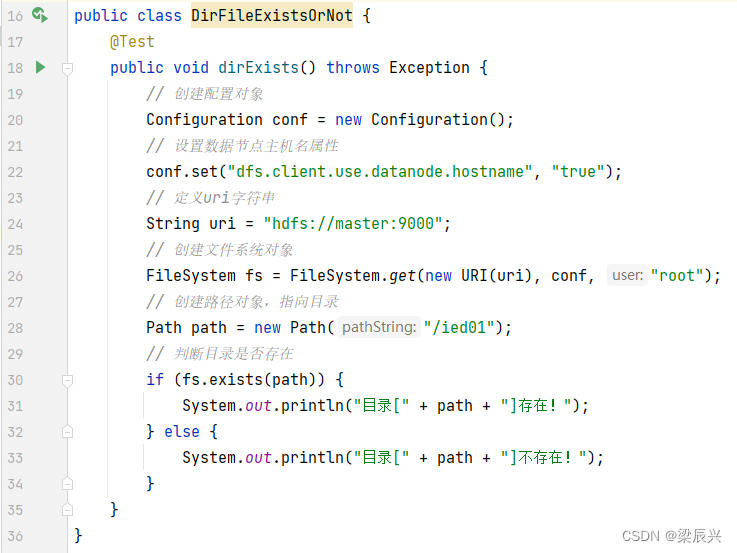 dirExists()源码
dirExists()源码
@TestpublicvoiddirExists()throwsException{// 创建配置对象 Configuration conf =newConfiguration();// 设置数据节点主机名属性
conf.set("dfs.client.use.datanode.hostname","true");// 定义uri字符串 String uri ="hdfs://master:9000";// 创建文件系统对象 FileSystem fs =FileSystem.get(newURI(uri), conf,"root");// 创建路径对象,指向目录 Path path =newPath("/ied01");// 判断目录是否存在 if(fs.exists(path)){System.out.println("目录["+ path +"]存在!");}else{System.out.println("目录["+ path +"]不存在!");}}
运行dirExists()方法,查看结果
修改代码,再测试

(3)创建fileExists()方法
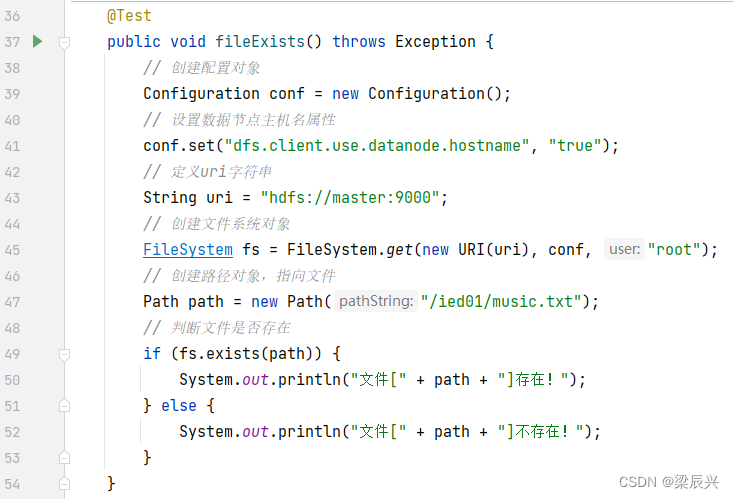 fileExists()源码
fileExists()源码
@TestpublicvoidfileExists()throwsException{// 创建配置对象 Configuration conf =newConfiguration();// 设置数据节点主机名属性
conf.set("dfs.client.use.datanode.hostname","true");// 定义uri字符串 String uri ="hdfs://master:9000";// 创建文件系统对象 FileSystem fs =FileSystem.get(newURI(uri), conf,"root");// 创建路径对象,指向文件 Path path =newPath("/ied01/music.txt");// 判断文件是否存在 if(fs.exists(path)){System.out.println("文件["+ path +"]存在!");}else{System.out.println("文件["+ path +"]不存在!");}}
运行fileExists()方法,查看结果
13 判断Path指向目录还是文件
(1)在net.hw.hdfs包里创建PathToFileOrDir类
1.右击【net.army.hdfs】包,选择【New】,单击【Java Class】
2.在弹出的对话框中输入:PathToFileOrDir,按下回车键,创建成功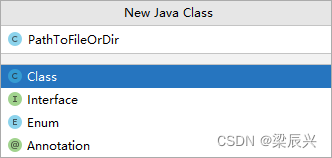
(2)编写代码,进行判断
PathToFileOrDir源码
packagenet.army.hdfs;importorg.apache.hadoop.conf.Configuration;importorg.apache.hadoop.fs.FileSystem;importorg.apache.hadoop.fs.Path;importjava.net.URI;/**
* 作者:Army
* 日期:2022/12/12
* 功能:判断路径指向目录还是文件
*/publicclassPathToFileOrDir{publicstaticvoidmain(String[] args)throwsException{// 创建配置对象Configuration conf =newConfiguration();// 设置数据节点主机名属性
conf.set("dfs.client.use.datanode.hostname","true");// 定义uri字符串String uri ="hdfs://master:9000";// 创建文件系统对象FileSystem fs =FileSystem.get(newURI(uri), conf,"root");// 创建路径对象,指向目录Path path1 =newPath("/ied08");if(fs.isDirectory(path1)){System.out.println("["+ path1 +"]指向的是目录!");}else{System.out.println("["+ path1 +"]指向的是文件!");}// 创建路径对象,指向文件Path path2 =newPath("/lzy01/howard.txt");if(fs.isFile(path2)){System.out.println("["+ path2 +"]指向的是文件!");}else{System.out.println("["+ path2 +"]指向的是目录!");}}}
运行程序,查看结果 结果明显不对,说明程序逻辑上有问题,原因在于/ied08目录不存在,/lzy01/howard.txt文件不存在,修改代码,加上目录或文件存在与否的判断
结果明显不对,说明程序逻辑上有问题,原因在于/ied08目录不存在,/lzy01/howard.txt文件不存在,修改代码,加上目录或文件存在与否的判断 运行程序,查看结果
运行程序,查看结果
修改代码,改成存在的目录和文件 运行程序,查看结果
运行程序,查看结果
最终源码
packagenet.army.hdfs;importorg.apache.hadoop.conf.Configuration;importorg.apache.hadoop.fs.FileSystem;importorg.apache.hadoop.fs.Path;importjava.net.URI;/**
* 作者:Army
* 日期:2022/12/12
* 功能:判断路径指向目录还是文件
*/publicclassPathToFileOrDir{publicstaticvoidmain(String[] args)throwsException{// 创建配置对象Configuration conf =newConfiguration();// 设置数据节点主机名属性
conf.set("dfs.client.use.datanode.hostname","true");// 定义uri字符串String uri ="hdfs://master:9000";// 创建文件系统对象FileSystem fs =FileSystem.get(newURI(uri), conf,"root");// 创建路径对象,指向目录Path path1 =newPath("/ied01");if(fs.exists(path1)){if(fs.isDirectory(path1)){System.out.println("["+ path1 +"]指向的是目录!");}else{System.out.println("["+ path1 +"]指向的是文件!");}}else{System.out.println("路径["+ path1 +"]不存在!");}// 创建路径对象,指向文件Path path2 =newPath("/lzy01/test.txt");if(fs.exists(path2)){if(fs.isFile(path2)){System.out.println("["+ path2 +"]指向的是文件!");}else{System.out.println("["+ path2 +"]指向的是目录!");}}else{System.out.println("路径["+ path2 +"]不存在!");}}}
14 删除目录或文件
注:类似于HDFS Shell里的hdfs dfs -rmdir和hdfs dfs -rm -r命令
(1)在net.hw.hdfs包里创建DeleteFileOrDir类
1.右击【net.army.hdfs】包,选择【New】,单击【Java Class】
2.在弹出的对话框中输入:DeleteFileOrDir,按下回车键,创建成功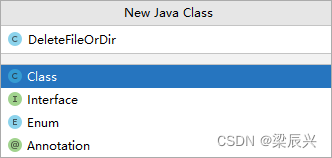
(2)删除文件
任务:删除/lzy01/hi.txt文件
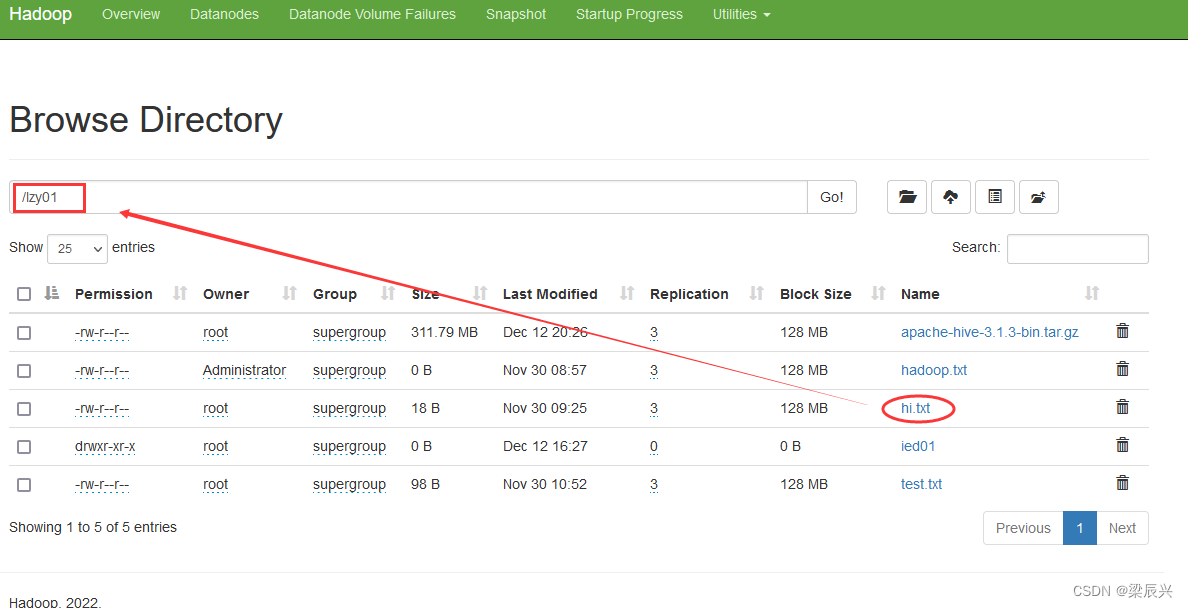 创建deleteFile()方法
创建deleteFile()方法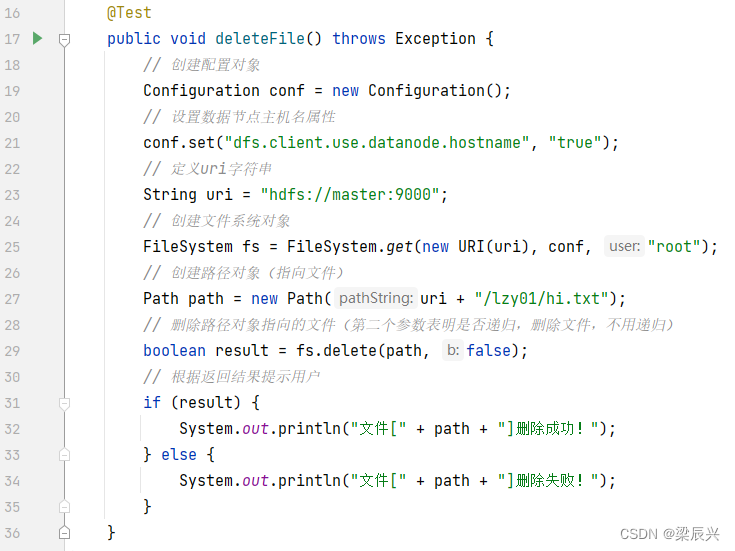 deleteFile()源码
deleteFile()源码
@TestpublicvoiddeleteFile()throwsException{// 创建配置对象 Configuration conf =newConfiguration();// 设置数据节点主机名属性
conf.set("dfs.client.use.datanode.hostname","true");// 定义uri字符串 String uri ="hdfs://master:9000";// 创建文件系统对象 FileSystem fs =FileSystem.get(newURI(uri), conf,"root");// 创建路径对象(指向文件) Path path =newPath(uri +"/lzy01/hi.txt");// 删除路径对象指向的文件(第二个参数表明是否递归,删除文件,不用递归) boolean result = fs.delete(path,false);// 根据返回结果提示用户 if(result){System.out.println("文件["+ path +"]删除成功!");}else{System.out.println("文件["+ path +"]删除失败!");}}
运行deleteFile()测试方法,查看结果 在Hadoop WebUI界面查看,已经没有hi.txt文件了
在Hadoop WebUI界面查看,已经没有hi.txt文件了 再运行deleteFile()测试方法,查看结果
再运行deleteFile()测试方法,查看结果
我们可以设计在删除文件之前,判断文件是否存在,需要修改代码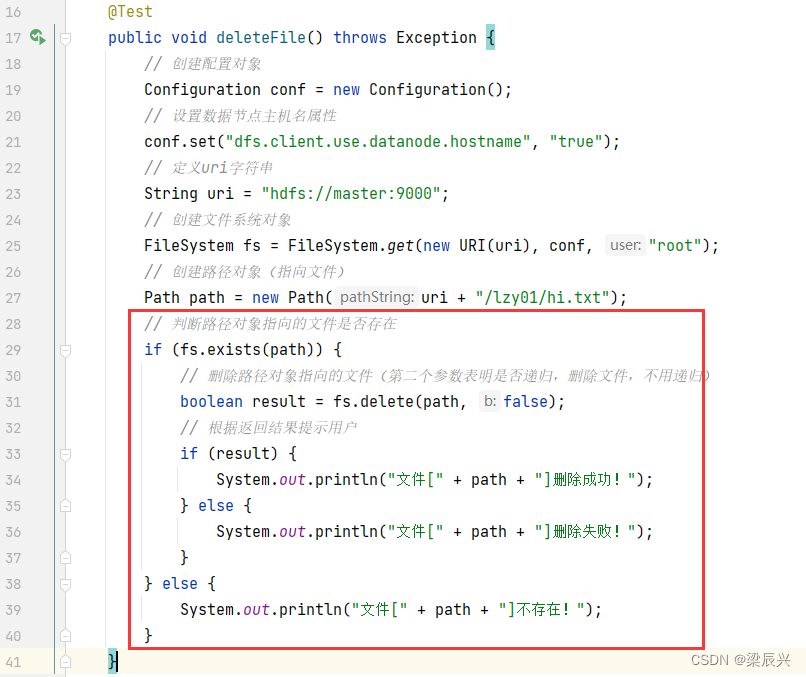
源码
@TestpublicvoiddeleteFile()throwsException{// 创建配置对象 Configuration conf =newConfiguration();// 设置数据节点主机名属性
conf.set("dfs.client.use.datanode.hostname","true");// 定义uri字符串 String uri ="hdfs://master:9000";// 创建文件系统对象 FileSystem fs =FileSystem.get(newURI(uri), conf,"root");// 创建路径对象(指向文件) Path path =newPath(uri +"/lzy01/hi.txt");// 判断路径对象指向的文件是否存在 if(fs.exists(path)){// 删除路径对象指向的文件(第二个参数表明是否递归,删除文件,不用递归) boolean result = fs.delete(path,false);// 根据返回结果提示用户 if(result){System.out.println("文件["+ path +"]删除成功!");}else{System.out.println("文件["+ path +"]删除失败!");}}else{System.out.println("文件["+ path +"]不存在!");}}
再运行deleteFile()测试方法,查看结果
(3)删除目录
任务:删除/lzy01目录
编写deleteDir()方法 deleteDir()源码
deleteDir()源码
@TestpublicvoiddeleteDir()throwsException{// 创建配置对象 Configuration conf =newConfiguration();// 设置数据节点主机名属性
conf.set("dfs.client.use.datanode.hostname","true");// 定义uri字符串 String uri ="hdfs://master:9000";// 创建文件系统对象 FileSystem fs =FileSystem.get(newURI(uri), conf,"root");// 创建路径对象(指向目录) Path path =newPath(uri +"/lzy01");// 判断路径对象指向的目录否存在 if(fs.exists(path)){// 删除路径对象指向的目录(第二个参数表明是否递归,删除文件,要递归) boolean result = fs.delete(path,true);// 根据返回结果提示用户 if(result){System.out.println("目录["+ path +"]删除成功!");}else{System.out.println("目录["+ path +"]删除失败!");}}else{System.out.println("目录["+ path +"]不存在!");}}
运行deleteDir()方法,查看结果 再运行deleteDir()方法,查看结果
再运行deleteDir()方法,查看结果
(4)删除目录或文件
注:进行三个层面的判断:判断是否存在、判断类型(目录或文件)、判断删除是否成功
任务:删除/ied02/read.txt文件和/lzy01目录
 编写delete()方法
编写delete()方法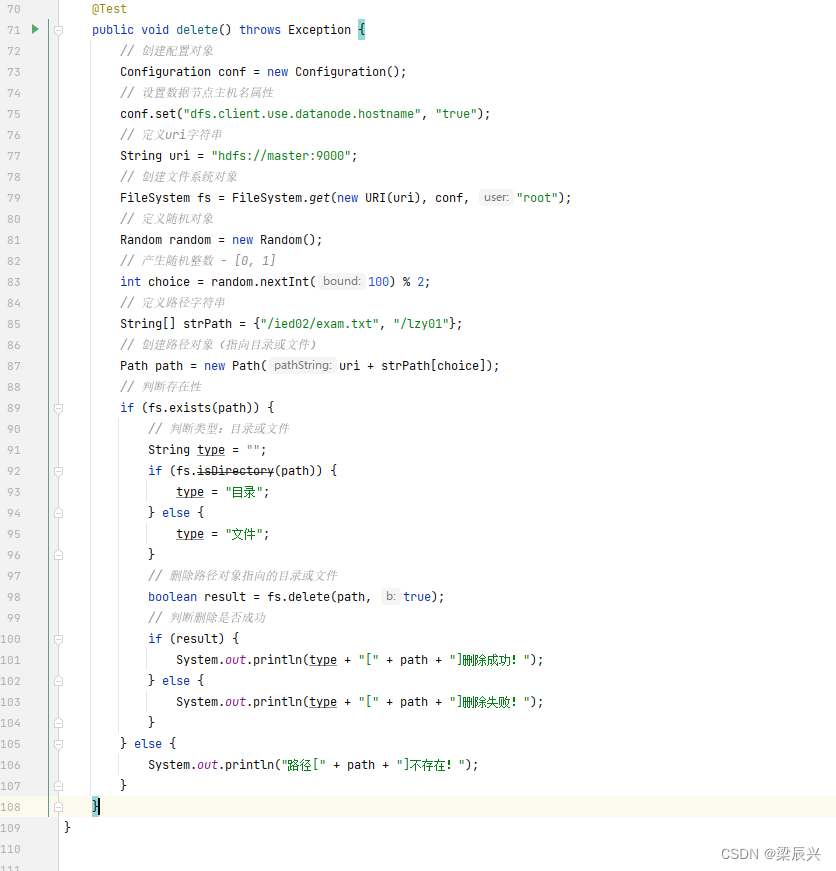
运行程序,查看结果
再次运行程序,查看结果
源码
@Testpublicvoiddelete()throwsException{// 创建配置对象 Configuration conf =newConfiguration();// 设置数据节点主机名属性
conf.set("dfs.client.use.datanode.hostname","true");// 定义uri字符串 String uri ="hdfs://master:9000";// 创建文件系统对象 FileSystem fs =FileSystem.get(newURI(uri), conf,"root");// 定义随机对象 Random random =newRandom();// 产生随机整数 - [0, 1] int choice = random.nextInt(100)%2;// 定义路径字符串 String[] strPath ={"/ied02/read.txt","/lzy01"};// 创建路径对象(指向目录或文件) Path path =newPath(uri + strPath[choice]);// 判断存在性 if(fs.exists(path)){// 判断类型:目录或文件 String type ="";if(fs.isDirectory(path)){
type ="目录";}else{
type ="文件";}// 删除路径对象指向的目录或文件 boolean result = fs.delete(path,true);// 判断删除是否成功 if(result){System.out.println(type +"["+ path +"]删除成功!");}else{System.out.println(type +"["+ path +"]删除失败!");}}else{System.out.println("路径["+ path +"]不存在!");}}
版权归原作者 梁辰兴 所有, 如有侵权,请联系我们删除。